We have just finished cooking supper after a really lovely day in and around Kristiansand. We have found it to be a very agreeable town, bustling with life and full of interesting streets of wooden houses, public gardens filled with bright flowers and beautiful surroundings with magnificent views of the coast with its many rocky islands.
We cycled into the town this morning. It is not so convenient here as in Denmark, with fewer cycle paths and a great deal of energy required getting up the hills. We have become rather unfit after so long on the flat plains of Northern Europe and are easily puffed out on hills we would hardly have noticed this time last year! It will do us good to be back in a landscape that makes our legs and lungs ache again.
 Kristiansand's heritage proudly reflected in its manhole covers
Kristiansand's heritage proudly reflected in its manhole coversKristiansand is a town built in wood. It surprised us but we find it very nice indeed. The buildings must take a lot of maintenance but most looked in good condition, painted mainly in white but also yellow, orange, rust and even a deep blue green. With their white wooden window frames they looked most attractive.
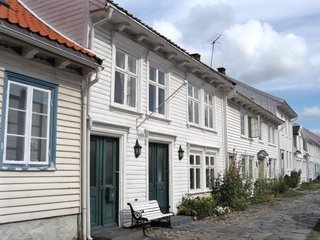 Typical wooden houses in the old town, Kristiansand
Typical wooden houses in the old town, Kristiansand 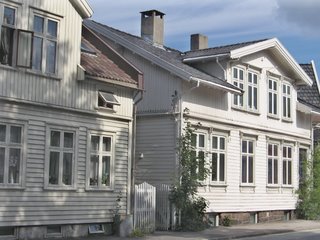 Typical wooden houses in the old town, Kristiansand
Typical wooden houses in the old town, Kristiansand Many of the buildings in the centre however are built in stone and concrete. Exploring the older, wooden-built part of the town we discovered a Methodist church and went to explore, never having been in a wooden church before. It was closed but seeing us outside the minister, a friendly young man with excellent English, invited us inside, proudly telling us he was actually a minister in the Pentecostal church and had only just taken over this church from the Methodists who were still able to use it as they all co-operated with each other. He chatted for some time telling us of the immigration problems in the town, of the migrant workers from Poland, of the large Vietnamese community who used the Catholic Church and of the growing Islamic community who had a tiny room they used as a mosque that was far too small for the numbers using it. He showed us the interior of his church explaining that a wall had to be rebuilt in brick because the neighbouring property had a fireplace behind it and there was a serious risk of the church catching fire. He explained that originally the entire town was built from wood but about a hundred years ago a huge fire had wiped out nearly half the buildings and it had been forbidden to rebuild in wood. Knowing this we could see, as we walked around the town later, just where the limits of the fire had reached, with one side of a street built in stone and the other still in wood.
 Wooden Methodist church, Kristiansand
Wooden Methodist church, Kristiansand At the internet café we were easily able to load on our latest blog. Sometimes we have enormous problems but today we were lucky. It cost us 30 kroner (just under £3) for the hour and the owner gave us a freshly brewed coffee each into the bargain.
Food prices in restaurants really are very expensive here so we went to one of the supermarkets to collate a picnic lunch. Here we found a counter selling assorted hot foods such as fish cakes, rissoles, pancake rolls etc. We didn't really know what they were but they looked interesting so we selected several to share. The lady there spoke charming English with a smile to match and explained what they all were. Mainly they seemed to be boiled fish dumplings with various seasonings. Some of them had also been fried.
We took them to one of the flowery squares and sat in the sunshine by a fountain where, helped by a large contingent of the sparrow population of the town, we tried them all out. They were rather stodgy but okay and remarkably filling. While there we saw several east European beggars playing accordions, much as we had done in Graz. This is obviously a popular destination for them as we saw none in Denmark or even Germany.
Nearby stood Kristiansand's cathedral, built in the 1880s with a stone exterior while the inside was constructed entirely in wood in the traditional style. It's not often one has the opportunity to enter a wooden cathedral! The style was very simple compared with the splendours we have experienced earlier in our travels, but we found the simple wooden roof, organ loft and columns most satisfying.
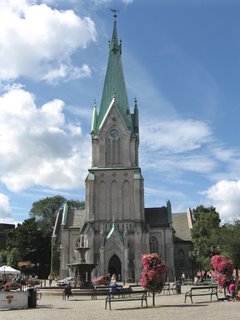 Cathedral, Kristiansand
Cathedral, Kristiansand  Wooden interior of Cathedral, Kristiansand
Wooden interior of Cathedral, Kristiansand Having enjoyed an inexpensive lunch we went for a coffee at a pleasant, ordinary self-service café. Our bill for a couple of coffees, a doughnut and a cream cake was over £10! It was a nice treat but we won't be doing that again! The shop also sold ice cream cornets. One scoop cost £2.30. One poor mum was buying one each for her three children! It must have been a special treat for being good we decided. Ian reckoned they must have been so good they were about to be canonised! In Germany we paid about 35 pence for the same quantity and even less in Hungary!
Children in both Denmark and Norway are beautiful. They are slim, sunbronzed with blond hair and blue eyes. They are well dressed and well behaved. They have open, friendly personalities and happy smiles. They grow up that way too. Everyone seems beautiful, well dressed and educated, friendly and happy.
It was such lovely weather, sunny but comfortable with a freshness to the air. We rejoined Hinge and Bracket and cycled off to Odderøya, one of the little islands in the sound, linked by a narrow bridge to the mainland. This was a pleasant place offering lovely views back to the town, or out over the sea to the many tree-covered islands and granite outcrops protruding above the water. Nobody else had ventured from the town centre on this midweek afternoon so it was a very peaceful place. We cycled, but mainly pushed, our bikes up the steep narrow road through the woodland strewn with huge granite boulders, until we came out at the top with spectacular views out to sea where the ferry from Denmark could be seen in the distance heading towards the town. This island had previously been under military control with gun emplacements, batteries and munitions stores, but had recently been opened up to the public in much the same way as at Devil's Point on the Tamar estuary in Devon, although here many of the emplacements are German. The area reminded us very much of the Devon coast, the sea a brilliant blue sparking through the trees as we climbed. At the top we lazed on the rocks eating wild raspberries and bilberries, reflecting, regretfully on how quickly our year had passed but grateful that we would be returning to a county as beautiful as Devon which at its best can hold its own even with this lovely area of southern Norway.
 View from the batteries at Odderøya, Kristiansand
View from the batteries at Odderøya, Kristiansand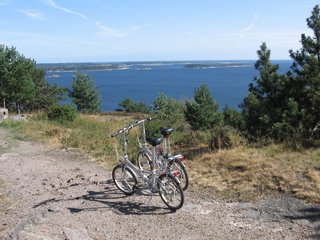 Hinge and Bracket admire the view from Odderøya, Kristiansand
Hinge and Bracket admire the view from Odderøya, Kristiansand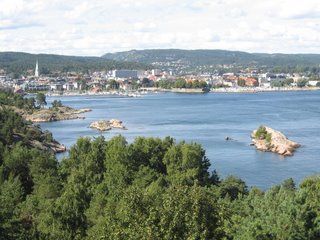 Kristiansand from the batteries at Odderøya
Kristiansand from the batteries at OdderøyaAround 5pm we cycled down the steep slope in a fraction of the time it had taken us to climb up there, and returned to the town where we shopped for essentials – eggs, vegetables, coffee and bread before cycling the few kilometres back to our campsite. Here we realised we had been overcharged last night. The campsite manager had charged us for a caravan and a car, having seen the back end of Modestine and not realised camping cars came that small. He immediately gave us a refund and even gave us free shower tokens into the bargain to make up for his error! We had been taken aback at the cost of the campsite last night so it was a relief to know it wasn't quite as bad as it seemed.
We cooked a proper supper with vegetables and potatoes. It's the first for ages as the weather is now cooler and we have left the land of cheap restaurants far behind. As we waited for it to cook we drank a glass of wine with our immediate neighbours. They are about our age, recently retired and from Denmark. They, like so many people we have met, are intrigued by Modestine. Currently they are using a tent and travelling only a few weeks at a time. They have "done" Britain from Lands End to John O'Groats and have travelled extensively in Ireland. They of course speak fluent English without even needing to know it for their work. As they said, everyone learns it automatically from infancy. Certainly we have noticed that even children's TV programmes are transmitted in English without being dubbed as they are in Germany, Spain and France. They also confirmed for us that Norwegian is so similar to Danish that people can understand each other with no problem. There is apparently more variation in dialect within Norway than between Norwegian and Danish! We haven't even noticed any difference and continue to read the signs everywhere, astonished at times that we cannot understand anything when people are speaking whereas it is often so easy to work out the written signs and notices we see around.
Thursday 17th August 2006, Egenes, near Flekkefjord, Norway
This country is superlatively beautiful. Slartibartfast really has done a first-class job of coastal design! How can one even consider that somewhere as dramatically beautiful as Norway might eventually fail to inspire the same sense of awe and wonder as on first acquaintance! We will describe what we saw today but once we have done that we suspect the following days will be a repetition of today - lakes, fjords, lakes, more fjords, lakes …
We left Kristiansand this morning along the North Sea route. Initially this follows the main road, which is very beautiful anyway, but soon it branches off towards the sea and follows the dramatic coastal route west and north, twisting its way through little hamlets, turning inland to negotiate the many fjords, circumnavigating inland lakes scoured out from the granite mass during the ice age to leave sheets of deep, dark clear water that plunge through the rock to what seems an awesome depth. Frequently we were driving along a narrow neck of land with a fjord on one side and a lake on the other. Without the map we would have found it difficult to know which was which. We had expected far more traffic. In general the narrow twisting lanes that wind their way through woods, rocks and water are very empty but therein lies the danger. Countless bends on narrow lanes with water to one side and rocks to the other can be quite tiring to cope with when intermittently an oncoming vehicle is unexpectedly encountered. Periodically our route took us back to the main road for a few kilometres before we branched off down towards the sea again. Our map is useful but after Ordnance Survey and Michelin, Ian finds many of the national maps of very inferior cartographic quality. If we missed a turning we risked ending up on a headland on the wrong side of a fjord with no way across.
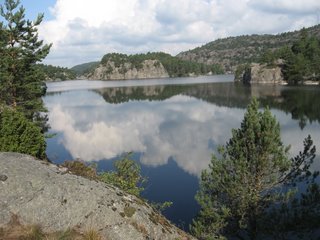 Sky reflected in the lake, near Kristiansand
Sky reflected in the lake, near Kristiansand So our progress has been slow but the day has been quite magnificent. The sun has been comfortably warm and we have stopped countless times to wonder at the scenery. Around 11 am we parked near a lonely jetty on one of the fjords near Trende with a few fishing boats moored and settled on the boardwalk with mugs of coffee brewed in Modestine. Here we peered into the depths of the water at thousands of tiny fishes, swaying sea weed and pulsating jelly fish. Fascinating and beautiful as we found it, we were shocked at just how deep the clear water appeared to be beneath the wooden planks we were sitting on, just a few feet out from the shore. Paddling is definitely not a holiday activity in Norway! The sides just sink away, vertically down to a bottomless depth.
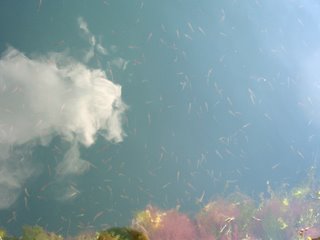 Fishes and seaweed in the fjord with cloud reflection
Fishes and seaweed in the fjord with cloud reflectionEverywhere today the rugged granite hills have loomed around us, their slopes dressed in pines, birches and rowans with their glowing berries. The leaves are already tinged with yellow and beside the roads, mixed with the purple heather there are myrtle bushes, raspberries, ripening blackberries and rosehips. Above, the blue sky is flecked with wisps of light clouds and where the road climbs steeply upwards towards the neck of a fjord, houses, farms and cattle enclosures lie amidst the woodland like tiny toys on the valley floor far below.
We stopped at Mandal on the Mannafjorden. This is a very pretty little town where every building is constructed in wood. Some are large and ornate while others are tiny cottages with flowers at the windows. All roads lead down to the water which can be glimpsed along the side streets from anywhere in the town. One of the most impressive buildings was the library, constructed from white painted wood but with a classic interior that belied its construction. The library was excellent and it offered free internet though using some unknown software that proved unable to cope with hotmail. The building stands in beautiful gardens on the water's edge and has to count as one of the most lovely settings for a library we have encountered anywhere.
 Street of wooden houses in Mandal with the library on the right.
Street of wooden houses in Mandal with the library on the right. 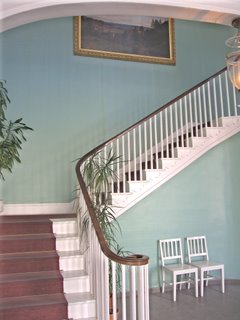 Main entrance to the library, Mandal
Main entrance to the library, Mandal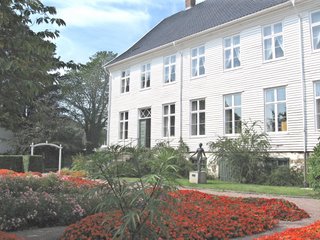 Library and its garden seen from the seafront, Mandal
Library and its garden seen from the seafront, Mandal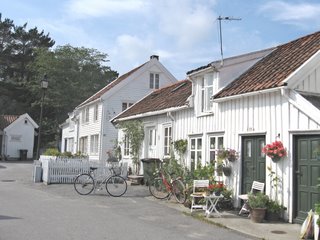 Wooden cottages in a side street, Mandal
Wooden cottages in a side street, MandalWe bought a couple of plain bread rolls for later and a chicken roll to share for lunch. The bill was £6.80. Norway is perhaps the most expensive country we have visited, easily passing Denmark. Campsites average around £19 a night and diesel is about £1.00 a litre, which is way ahead of any other country we have visited during our travels. In Denmark, the next most expensive, it cost around 80 pence a litre.
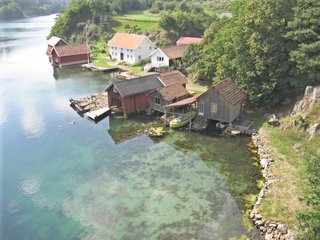 View from the bridge at Jasund with boat houses
View from the bridge at Jasund with boat housesDuring the afternoon we stopped at Farsund, another attractive wooden town on the Lyngdalsfjorden where we strolled along the quays in the sunshine.
 Door to the town hall, Farsund
Door to the town hall, Farsund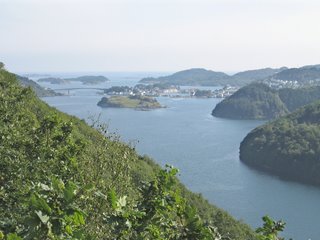 View back towards Farsund across the Lyngdalsfjorden
View back towards Farsund across the Lyngdalsfjorden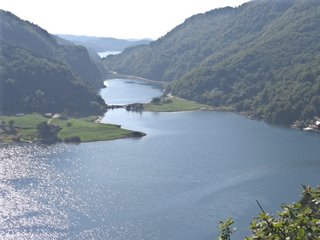 View along the Lyngdalsfjorden
View along the LyngdalsfjordenThere must be as much water as land in Norway. Travelling is just a question of threading your way between the different waters and ensuring you don't get cut off by a wall of rock or a sheet of water. Around 5.30pm we saw a campsite run by a religious mission. The setting was beautiful, right beside the edge of a lake, silent and peaceful. There was nobody around however and we hesitated to set up camp and pay later as we couldn't understand the price guide on the door. It implied phenomenal costs but was probably quoting for hiring a chalet for a week rather than using your own vehicle for a night, but we were not sure. So we drove on a further 20 kilometres to the next site marked on our map. Here there were road works and a new tunnel was being blasted through the mountain so we were diverted and never discovered the campsite. Eventually, on the outskirts of Flekkefjord we stopped and looked down into the valley where we saw some caravans. We found our way down here and have happily settled for the night after a very pleasant walk beside the lake or fjord – we've given up trying to work out which it might be but as it didn't taste salt we assume it is a lake.
 View down onto our campsite at Egenes
View down onto our campsite at EgenesThis is only southern Norway. Maybe things are even bigger further north, maybe there are the wonders of the midnight sun, perpetual night, the aurora borealis, snowy mountains and breath-taking boat trips. This is however, quite magnificent enough for us. It is perhaps rather like several of Britain's most beautiful areas rolled into one and then made bigger. The granite mountains are rounded, weathered and shaped by ice, reminiscent of Scotland. The deep lakes, scoured out by ice remind us of the Lake District while the deep sea inlets and many wooded islands are rather like the inlets around south Devon. However, here it is the whole country and on a significantly grander scale. It is quite different from anything else we have experienced during our year and a stunning way to round it off.
Friday 18th August 2006, Brusand, near Egersund, Norway
We have a crisis! Before we left Germany we stocked up on wine as we understood it to be very expensive in Denmark. We found it for sale on the supermarket shelves there from around £3 per bottle. Relieved, we happily imbibed as we wrote about troll migration and ballroom dancing. Today we discovered our supply was running rather low so popped into the supermarket for another bottle. No wine on the shelves and not much beer either. With a sense of foreboding we searched the town until we discovered a back street shop run by Vinmonopolet, which appears to be a special division of the Norwegian civil service. Here the shelves were lined with serried ranks of alcohol ranging from hard spirits to cider. Even though Norway is now a member of the EU and presumably subject to the same laws of free trade within the community as the rest of us, the sale of all wines and spirits in the country is under government control. They cannot be purchased anywhere except these special shops where, needless to say, a hefty government tax is levied. So hefty is it that it costs more to purchase a bottle of Minervois, Corbières or Medoc to take home with you than it would to buy in an expensive restaurant in England! The cheapest we found, which didn't look very special, was £6 a bottle, average prices were more in the region of £10! Just to think we were almost bathing in it back in Ambre-les-Espagnolettes last autumn! Oh for five litres of Mme. Js. "super" straight from the vat!
Beer too is very expensive with an additional charge levied on every can sold to encourage their return to the shop of purchase when, if you can understand the Norwegian instructions on the special machine you are required to communicate with, you may get your kroner back again. Carlsberg beers from Denmark seem to have cornered most of the beer market up here. Is that what they mean by "reaching the parts other beers cannot reach"?
We are now rationing ourselves to make our last couple of litres last as long as possible. We have been thinking of staying in Norway until the end of August. We might be reduced to getting an earlier ferry to Newcastle and spending the last week until we get our house back on a campsite in Northumberland drinking Newcastle Brown instead!
Apart from that tale of woe the day has been rather good. This morning it felt like deep autumn on the campsite with the sun hidden behind the looming mountains of granite. Everywhere was damp and wet. Our windscreen was running water inside and out and it was too chilly to breakfast outside. We definitely feel the year has gone full circle since we started our big adventure. Soon though everywhere dried up and we were driving through sunshine beside the fjord down into the little town of Flekkefjord. This really is a pretty little town where almost every building is in white wood with huge baskets of pink and blue petunias hanging from their fronts. Even the octagonal church is in wood and has been sympathetically restored to its original appearance back in the 1830s.
 Introducing Flekkefjord
Introducing Flekkefjord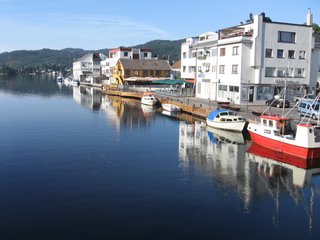 Harbour at Flekkefjord
Harbour at Flekkefjord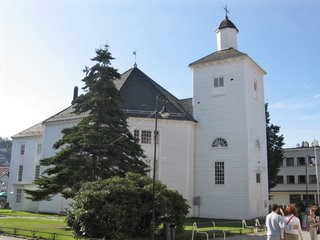 Octagonal wooden church at Flekkefjord
Octagonal wooden church at Flekkefjord Interior of the octagonal wooden church at Flekkefjord
Interior of the octagonal wooden church at FlekkefjordWith more time and energy we could have spent a very interesting and healthy day
pedalling a tricycle made for two along 17 kilometres of railway track between Flekkefjord and Sira. The railway between these two towns closed in the 1980s but the track remained. Someone had the inspired idea of using the special bikes used by the track inspectors and designed to run on the rails, as a tourist attraction. These rusty, battered vehicles have metal flanged wheels that fit over the rails and masochists can hire them to pedal their way along through 17 tunnels on a single track railway line. Of course the speed is dictated by the slowest pedaller on the route and we still haven't worked out how people got back. Did they have to keep lifting their bikes off to let those coming up pass, and then fix them on again?
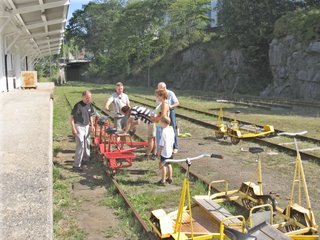 Railbikes, Flekkefjord
Railbikes, FlekkefjordExploring the old town – which claims to be Dutch in style but to us it looked very Norwegian and not the least bit Dutch – we discovered the wooden library on the very edge of the fjord. It is yetanother of the loveliest settings for a library we have seen and we went in to investigate further. The staff were really friendly and showed us around, pleased that English librarians were interested in their library. They showed Ian their microfilmed church records and local history room as well as giving us a tour of the rest of the building. The visit also provided an opportunity to check up on ferry times and prices. Depending on our progress and the weather we may return to England from Bergen rather than Stavanger. Our local history library friend Elizabeth of York has told us we have absolutely got to visit Bergen and we do try to do as we are told!
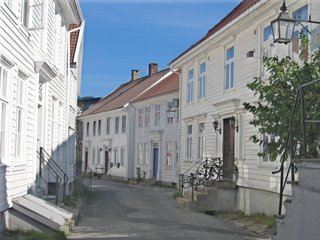 So called Dutch Town, Flekkefjord
So called Dutch Town, Flekkefjord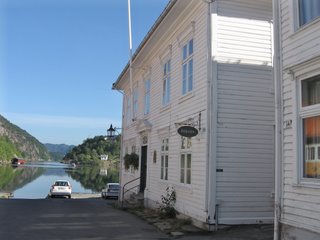 Flekkefjord library
Flekkefjord library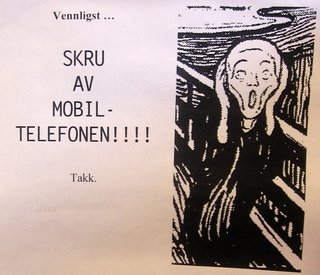 Who said librarians had no sense of humour? Notice in Flekkefjord library
Who said librarians had no sense of humour? Notice in Flekkefjord libraryWe moved on up the coast. It was every bit as beautiful as yesterday and we stopped for a picnic lunch on a mossy rock under the shade of silver birch and rowan trees right on the edge of a deep lake where the rocks on which we sat plunged vertically down into the water, blue-green where the light shone, turning dark where the depth became even greater. On the opposite side of the lake massive, dark, bare granite rocks raised themselves high into the blue sky with here and there a huge boulder balanced on their rounded tops. Presumably these boulders have been there since they were left by the retreating ice caps but they look ready to topple down into the water at any moment.
 Mountain lake west of Flekkefjord
Mountain lake west of FlekkefjordOur route from here was magnificent. The route became increasingly narrow. Fortunately there was not much traffic as the road twisted its way around wall after wall of granite rock, struggling steeply up the side of Jøssingfjord to disappear suddenly into a long tunnel through the rock. Exiting beyond we found ourselves looking down onto the route we had just struggled so hard to climb.
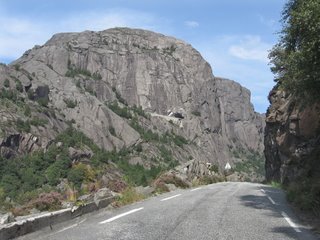 Modestine drove through the tunnel seen on the rock face above Jøssingfjord!
Modestine drove through the tunnel seen on the rock face above Jøssingfjord! 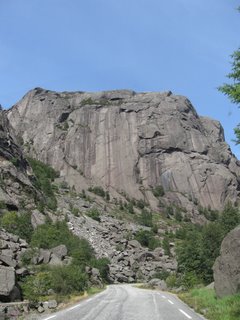 Our road climbing through scree above Jøssingfjord!
Our road climbing through scree above Jøssingfjord! Soon we reached the highest point and spread before us was a seemingly endless desert of gigantic, rounded granite summits. Now we twisted our way down, the rocks gradually rising around us with constant vistas of water.
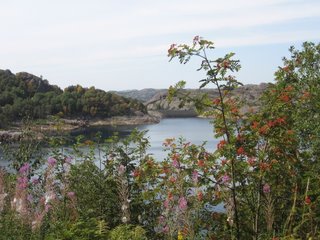 Mountain lake at Åvendal with rowan trees
Mountain lake at Åvendal with rowan treesThese lakes were at a high altitude but eventually we reached sea level again and followed the coast road around to Egersund. It was a little disappointing compared to Flekkefjord but pleasant enough with an attractive wooden church.
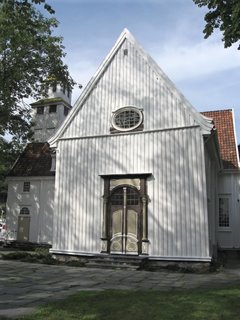 Church at Egersund
Church at EgersundFrom here we moved on searching out a campsite. The landscape became lower near the coast and the boulders, rocks and hills less dramatic. Here we could have believed ourselves in northern England. Eventually even these eased away and we found ourselves following a flat coastal route through sand dunes! Here we have found a pleasant campsite for the night. It is run by Germans for Germans. They are very different from the Germans we met in Hungary who were mainly retired and sick, overweight with smoking problems. Here they are young, active, with families of happy children. They spend their holiday with shrimping nets in the rock pools at the sea's edge, beyond the sand dunes.
The sandy coast strikes us as more interesting here than in Denmark. The shoreline is sometimes a jumble of sculpted boulders, there are rock pools, little sheltered coves for mooring crabbing boats and the beach is littered with wooden lobster cages and fishing tackle. All the boulders here are large, shaped by the ice and the sea. Anything smaller has been transported by the ice sheets across the sea to lie on the beaches of Jutland.
